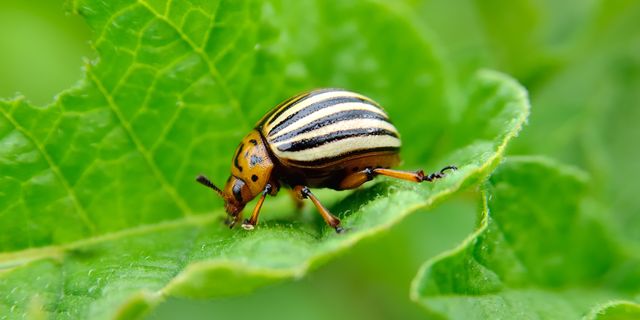No gardener wants to see insects wreaking havoc on a bed full of ripening produce. Luckily, it's possible to keep unwelcome visitors away. Since some pesticides can hurt the beneficial bugs that actually help your plants, try these easy control measures first before resorting to the strong stuff.
1. Aphids
These tiny, pear-shaped critters have long antennae and two tubes projecting rearward from their abdomen. They usually hang out on most fruits and vegetables, flowers, ornamentals, and shade trees throughout North America. Aphids suck plant sap, causing foliage to distort and leaves to drop; honeydew excreted on leaves supports sooty mold growth; and feeding spreads viral diseases. To control these bugs:
- Wash plants with strong spray of water
- Encourage native predators and parasites such as aphid midges, lacewings, and lady beetles
- When feasible, cover plants with floating row covers
- Apply hot-pepper or garlic repellent sprays
- For severe problems, apply horticultural oil, insecticidal soap, or neem oil
2. Cabbage Maggot
These stick to cabbage-family crops, especially Chinese cabbages, and live throughout North America. The maggots tunnel in roots, killing plants directly or by creating entryways for disease organisms. To control these destructive creatures, try these methods:
- Apply floating row covers
- Set out transplants through slits in tar-paper squares
- Avoid first generation by delaying planting
- Apply parasitic nematodes around roots
- Burn roots from harvested plants
- Mound wood ashes or red pepper dust around stems
3. Caterpillars
Caterpillars are soft, segmented larvae with distinct, harder head capsule with six legs in the front and fleshy false legs on rear segments. They can be found on many fruits and vegetables, ornamentals, and shade trees. Caterpillars chew on leaves or along margins; some tunnel into fruits. To deter them:
- Encourage native predators and parasites
- Hand-pick your harvest
- Apply floating row covers
4. Cutworms
Cutworms are fat, 1-inch-long, gray or black segmented larvae most active at night. They are found on most early vegetable and flower seedlings and transplants throughout North America. Cutworms chew through stems at ground level; they may completely devour small plants in May and June. For control:
- Use cutworm collars on transplants
- Delay planting
- Hand-pick cutworms curled below soil surface
5. Colorado Potato Beetle
Adults are yellow-orange beetles with ten black stripes on wing covers. They're found on potatoes, tomatoes, cherry tomatoes, eggplant, and petunias throughout North America. These beetles defoliate plants, reducing yields or killing young plants. To control:
- Apply floating row covers
- Use deep straw mulches
- Hand pick
- Attract native parasites and predators
- Spray with neem oil
6. Mexican Bean Beetle
Adults are oval, yellow-brown, 1/4-inch beetles with 16 black spots on wing covers, while larvae are fat, dark yellow grubs with long, branched spines. They are found on cowpeas, lima beans, snap beans, soybeans in most states east of the Mississippi River as well as parts of Arizona, Colorado, Nebraska, Texas, and Utah.
Adults and larvae chew on leaves from beneath, leaving behind a lacy appearance. To control:
- Apply floating row covers
- Plant bush beans early
- Hand pick
- Plant soybean trap crop
- Out out lures to draw spined soldier bugs (predators) to your yard
- Spray with insecticidal soap or neem oil
7. Flea Beetle
Flea beetles are small, dark beetles that jump like fleas when disturbed. They hang out on most vegetable crops and are found throughout North America. Adults chew numerous small, round holes into leaves (most damaging to young plants), and larvae feed on plant roots. For control:
- Apply floating row covers
- Spray plants with garlic spray or kaolin clay
8. Tarnished Plant Bug
These are fast-moving, mottled, green or brown bugs that have forewings with black-tipped yellow triangles. They can be found on many flowers, fruits, and vegetables throughout North America. Adults and nymphs suck plant juices, causing leaf and fruit distortion, wilting, stunting, and tip dieback. To control these bugs:
- Keep your garden weed-free in spring
- Apply floating row covers
- Encourage native predatory insects
- Spray young nymphs with neem oil
9. Japanese Beetles
Adults are metallic blue-green, ½-inch beetles with bronze wing covers, while larvae are fat, white grubs with brown heads. They can be found on many vegetables, flowers, and small fruit in all states east of the Mississippi River. Adults skeletonize leaves, chew flowers, and may completely defoliate plants while larvae feed on lawn and garden plant roots. To control these insects:
- Shake beetles from plants in early morning
- Apply floating row covers
- Set out baited traps upwind of your vegetable garden on two sides and at least 30 feet away
- Spray beetles with insecticidal soap
10. Scales
Adult females look like hard or soft bumps on stems, leaves, or fruit; males are minute flying insects and larvae are tiny, soft, crawling insects with threadlike mouthparts. They can be found on many fruits, indoor plants, ornamental shrubs, and trees throughout North America. All stages suck plant sap, therefore weakening plants. Plants become yellow, drop leaves, and may die. Honeydew is also excreted onto foliage and fruit. For control:
- Prune out infested plant parts
- Encourage native predators
- Scrub scales gently from twigs with soft brush and soapy water, and rinse well
- Apply dormant or summer oil sprays
- Spray with neem oil













